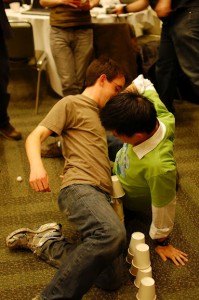GDC 2012: Folk Games
Having finished my degree the previous summer, it would appear that everything should just go “back to normal”. The craziness is over, my brief foray into a bizarre and even slightly antagonistic field (Physics) has come to an end, and now I can return to the workforce with renewed vigor. Because there is only so much exploration a person can do, right?
But it seems that 2012 is already distinguishing itself from previous years. Just over a week ago, I found myself nearly halfway around the world, attending a conference with the most energetic, talented and interesting people I could possibly dream of. This was the Game Developers Conference, held in San Francisco, USA.
A few themes permeated the conference in my perception, themes that resonated with me, my thoughts, and the mindset that brought me ten time zones west of home. In the hopes of making this a mini-series of posts, I’ll discuss one of these themes here.
I’d like to talk about folk games. The first time I had ever heard the term “folk game” was at the inspiring session given by Douglas Wilson (of Die Gute Fabrik). All but devoid of tactical and strategical elements, these mostly physical games are generally very simple and easy to learn, and demand a certain cunning and skillful coordination. According to Douglas, a good folk game makes the players feel extremely competent (or able to gain mastery over the game), while being extremely entertaining to watch. One game cited had blindfolded players dueling with wooden spoons in slow motion. The popularity of the game was attributed as much to how “badass” it feels to move in slow motion as it was to watching someone move in slow motion being “really fucking hilarious”.
So folk games are fun for all involved, even if only an observer. In the blindfolded example, the spectators play an important role of mediation — bystanders must verbally discourage players who move too fast. This theatrical element immediately brings the folk game into a broader context of interaction between people. It affords a place and justification to make a fool out of one’s self among friends.
Of all the games Douglas presented in his talk, my favorite remains the only one made by Die Gute Fabrik that I’ve played: Johann Sebastian Joust. The game is reminiscent of Lemon Jousting, where players attempt to knock the lemon off their opponents’ wooden sticks while protecting their own. But JS. Joust has an extra layer too it, which is the computer. A lemon on a stick is an excellent feedback mechanism indeed — however, there is something intrinsically external about having a computer mediate. I feel it adds a great sense of fairness to the game, and less of a need to rely on “house rules”. Winning is extremely satisfying, and losing tends to make you think, “I can do better next time”, accompanied by a desire to play again.
It might seem unrelated, but I find that Bennett Foddy‘s work is extremely in tune with this sort of philosophy. In Bennett’s talk (by absolute coincidence, right before Douglas’s), he explains how he believes that the player wants to be humiliated and frustrated. He showed a video of the ending of his game GIRP, in which the player took too long to reach the prize at the end. Winner: Bird. This subversive move on Bennett’s part brings to light so many positive aspects of his game: the emotional connection made during those fateful 20 minutes. The fact that the player actually uploaded this video to YouTube, “shaming” himself in the face of the world. And the idea that when the player does finally beat the game, he will have achieved a mastery over it. Similar to folk games, Bennett’s projects are extremely simple to understand, needing little to no explanation. Finally, a collaboration between Bennett and Douglas led to Mega-GIRP, which turns regular GIRP into a single-player game of twister. This modified version is even harder than the already-hard game, and players look ridiculous playing it. This kind of spectacle sport becomes a nexus of truly social gaming among groups of people.
Early on in the conference, I had the pleasure of being involved in an unusual game jam. Many people were involved with the final product, among them Harry Lee, Stephen Lavelle, Sara G, Stephen A, Matt Thorson, and Alan Hazelden. Instead of focusing on graphics or programming, physical props were laid out and explored. Paper cups, chairs, and some dice Harry had that denoted parts of the body. The game we ended up playing was dubbed “Get it Up” (photos here!). Two players go at a time, each rolling a die. They then have to transfer a single paper cup from one pyramid to another pyramid, while only using the body part designated by the die. The group wins when the new pyramid is completely built.
Another example was the game DRINK, by Anna and Loren, which is a real-world drinking game played against a virtual opponent.
How can I summarize and/or wrap up this post?? There’s a growing feeling of moving games into a shared physical space, while taking advantage of available technology to aid the way. Let’s make more games!!!
In: Uncategorized · Tagged with: folk games, gdc, gdc12, get it up, photos, rant, san francisco

